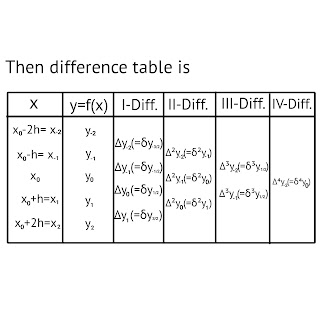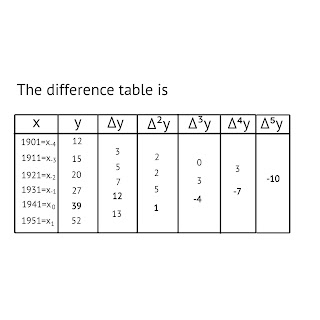Gauss's central difference formula for equal intervals:
We shall develop central difference formulae which are best suitable for interpolation near the middle of the tabulated set (table).
x: x₋₂ x₋₁ x₀ x₁ x₂
y=f(x): y₋₂ y₋₁ y₀ y₁ y₂
 |
| Difference table. |
Gauss's forward interpolation formula for equal intervals:
f(x) = y₀+[u/1!]∆y₀+{[u(u-1)]/2!}∆²y₋₁+{[(u+1)(u)(u-1)]/3!}∆³y₋₁+{[(u+1)u(u-1)(u-2)]/4!}∆⁴y₋₂ +......., Where u= (x-x₀)/h
Remark:
This formula is applicable when u lies between 0 and 1 i.e (0<u<1).
Example: Using Gauss's forward formula to evaluate y₃₀ given that y₂₁=18.4708, y₂₅=17.8144, y₂₉=17.1070, y₃₃=16.3432 and y₃₇=15.5154.
To find y=f(x) at x=30, i.e f(30):
Taking x₀ = 29, h=4, x=30, then u= (x-x₀)/h = (30-29)/4 = 0.25
Using Gauss's forward difference formula
f(x) = y₀+[u/1!]∆y₀+{[u(u-1)]/2!}∆²y₋₁+{[(u+1)(u)(u-1)]/3!}∆³y₋₁+[(u+1)u(u-1)(u-2)/4!]∆⁴y₋₂ +......
=> f(30) = y₃₀ = 17.1070+(0.25)(-0.7638) + [(0.25)(-0.75)]/2×(-0.564) + [(1.25)(.25)(-.75)]/6×(-0.0076) + [(1.25)(.25)(-0.75)(-1.75)]/24× (-0.0022)
=> f(30) = y₃₀ = 17.1070-0.19095+0.00529+0.0003-0.00004
=> y₃₀ = 16.92 Ans.
Gauss's backward interpolation formula:
f(x) = y₀+[u/1!]∆y₋₁+{[u(u+1)]/2!}∆²y₋₁+{[(u+1)(u)(u-1)]/3!}∆³y₋₂+[(u+2)(u+1)u(u-1)/4!]∆⁴y₋₂ +......., Where u= (x-x₀)/h
Remark:
This formula is applicable when u lies between -1 and 0.
Example: Find by Gauss's backward formula the sales of a concern for the year 1936, given that
Year: 1901 1911 1921 1931 1941 1951
Sale( in thousands rupees): 12 15 20 27 39 52
Solution. Taking the origin at 1941 and h=10,
u= (x-x₀)/h= (1936-1941)/10 = -0.5. [∵-1<u<0]
Using Gauss backward formula:
f(x) = y₀+[u/1!]∆y₋₁+{[u(u+1)]/2!}∆²y₋₁+{[(u+1)(u)(u-1)]/3!}∆³y₋₂+.......
=> f(1936)= 39 + (-.5)×(12)+[(.5)(-.5)]/2 × [(.5)(-.5)(-1.5)]/6 ×(-4)
=> f(1936)= 39-6-0.125-0.25 = 32.625 thousands Ans.


Comments
Post a Comment